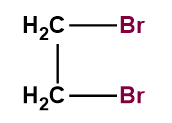
When ethylene bromide is treated with \[Zn\] we get
(a) Alkane
(b) Alkene
(c) Alkyne
(d) All
Answer
220.8k+ views
Hint: When two atoms or substituents which are connected to two neighboring carbon atoms undergo elimination via a one or two-step reaction pathway. Such reactions are recognized as elimination reactions.
Complete Step by Step Answer:
The given question represents the reaction of \[Zn\]with ethylene bromide.
The structure of ethylene bromide contains two bromine atoms which are seated on two adjacent carbon atoms. The structure of ethylene bromide can be represented below.

Figure: Structure of ethylene bromide.
When the alcoholic solution of ethylene bromide is treated with \[Zn\], the formation of ethylene molecules is observed with the formation of \[ZnB{r_2}\]salt.

Figure: Reaction of ethylene bromide with zinc.
In the above reaction the \[Zn\] behave as a de-halogenating or eliminating agent i.e., it causes the removal of adjacent bromine atoms on neighboring carbon atoms.
The question contains options such as an alkane, alkene, and alkyne. Hence, from the above explanation, it is clear that when ethylene bromide is heated with zinc the formation of ethylene (alkene) occurs. There is no alkane and alkyne formation observed.
Therefore, the option which contained alkane (a), alkyne (c) and mixture (d) is wrong.
Therefore, from the above discussion, it is quite clear that, option (b) will be the correct answer.
Note: The alkane, alkene and alkyne are saturated (alkane) and unsaturated (alkene and alkyne) hydrocarbons. Alkane is a saturated hydrocarbon, in which the carbon atoms contain the single bonds Alkene and alkyne belong to the family of unsaturated hydrocarbons in which the double and triple bond is present between the carbon atoms.
Complete Step by Step Answer:
The given question represents the reaction of \[Zn\]with ethylene bromide.
The structure of ethylene bromide contains two bromine atoms which are seated on two adjacent carbon atoms. The structure of ethylene bromide can be represented below.

Figure: Structure of ethylene bromide.
When the alcoholic solution of ethylene bromide is treated with \[Zn\], the formation of ethylene molecules is observed with the formation of \[ZnB{r_2}\]salt.

Figure: Reaction of ethylene bromide with zinc.
In the above reaction the \[Zn\] behave as a de-halogenating or eliminating agent i.e., it causes the removal of adjacent bromine atoms on neighboring carbon atoms.
The question contains options such as an alkane, alkene, and alkyne. Hence, from the above explanation, it is clear that when ethylene bromide is heated with zinc the formation of ethylene (alkene) occurs. There is no alkane and alkyne formation observed.
Therefore, the option which contained alkane (a), alkyne (c) and mixture (d) is wrong.
Therefore, from the above discussion, it is quite clear that, option (b) will be the correct answer.
Note: The alkane, alkene and alkyne are saturated (alkane) and unsaturated (alkene and alkyne) hydrocarbons. Alkane is a saturated hydrocarbon, in which the carbon atoms contain the single bonds Alkene and alkyne belong to the family of unsaturated hydrocarbons in which the double and triple bond is present between the carbon atoms.
Recently Updated Pages
Difference Between Alcohol and Phenol: Structure, Tests & Uses

Classification of Drugs in Chemistry: Types, Examples & Exam Guide

Class 12 Chemistry Mock Test Series for JEE Main – Free Online Practice

Is PPh3 a strong ligand class 12 chemistry JEE_Main

Full name of DDT is A 111trichloro22bispchlorophenyl class 12 chemistry JEE_Main

Sodium acetate on heating with soda lime produce A class 12 chemistry JEE_Main

Trending doubts
Understanding Atomic Structure for Beginners

Understanding Entropy Changes in Different Processes

Common Ion Effect: Concept, Applications, and Problem-Solving

What Are Elastic Collisions in One Dimension?

Free Radical Substitution and Its Stepwise Mechanism

Understanding Geostationary and Geosynchronous Satellites

Other Pages
NCERT Solutions For Class 12 Chemistry Chapter 9 Amines

Test for Phenolic Group

JEE Advanced 2026 Revision Notes for Practical Organic Chemistry

NCERT Solutions for Class 12 Chemistry Chapter 2 Electrochemistry

Convert chloro benzene to phenol class 12 chemistry JEE_Main

NCERT Solutions For Class 12 Chemistry Chapter 10 Biomolecules - 2025-26




